height VOLVO V4 2002 Owners Manual
[x] Cancel search | Manufacturer: VOLVO, Model Year: 2002, Model line: V4, Model: VOLVO V4 2002Pages: 88, PDF Size: 2.34 MB
Page 5 of 88
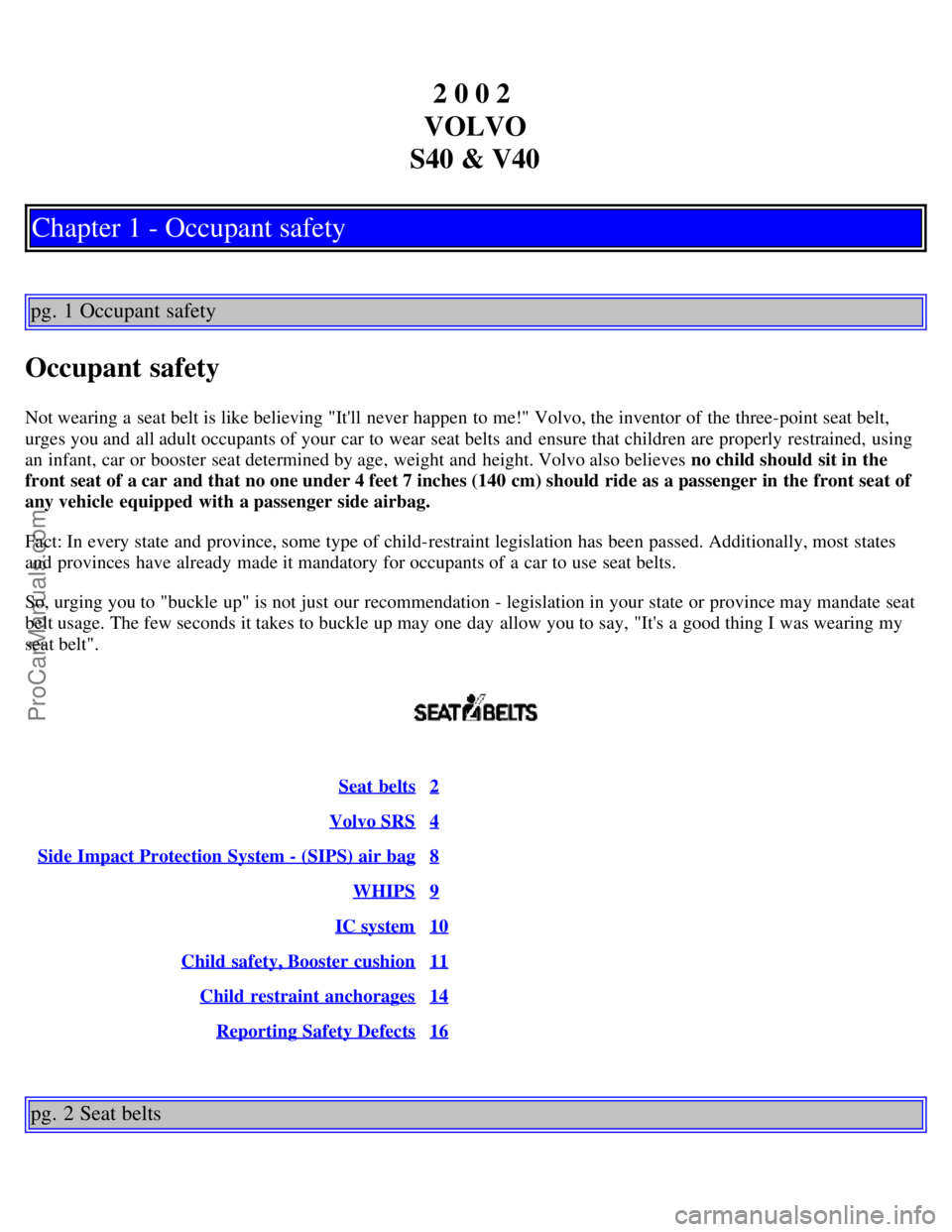
2 0 0 2
VOLVO
S40 & V40
Chapter 1 - Occupant safety
pg. 1 Occupant safety
Occupant safety
Not wearing a seat belt is like believing "It'll never happen to me!" Volvo, the inventor of the three-point seat belt,
urges you and all adult occupants of your car to wear seat belts and ensure that children are properly restrained, using
an infant, car or booster seat determined by age, weight and height. Volvo also believes no child should sit in the
front seat of a car and that no one under 4 feet 7 inches (140 cm) should ride as a passenger in the front seat of
any vehicle equipped with a passenger side airbag.
Fact: In every state and province, some type of child-restraint legislation has been passed. Additionally, most states
and provinces have already made it mandatory for occupants of a car to use seat belts.
So, urging you to "buckle up" is not just our recommendation - legislation in your state or province may mandate seat
belt usage. The few seconds it takes to buckle up may one day allow you to say, "It's a good thing I was wearing my
seat belt".
Seat belts2
Volvo SRS4
Side Impact Protection System - (SIPS) air bag8
WHIPS9
IC system10
Child safety, Booster cushion11
Child restraint anchorages14
Reporting Safety Defects16
pg. 2 Seat belts
ProCarManuals.com
Page 6 of 88
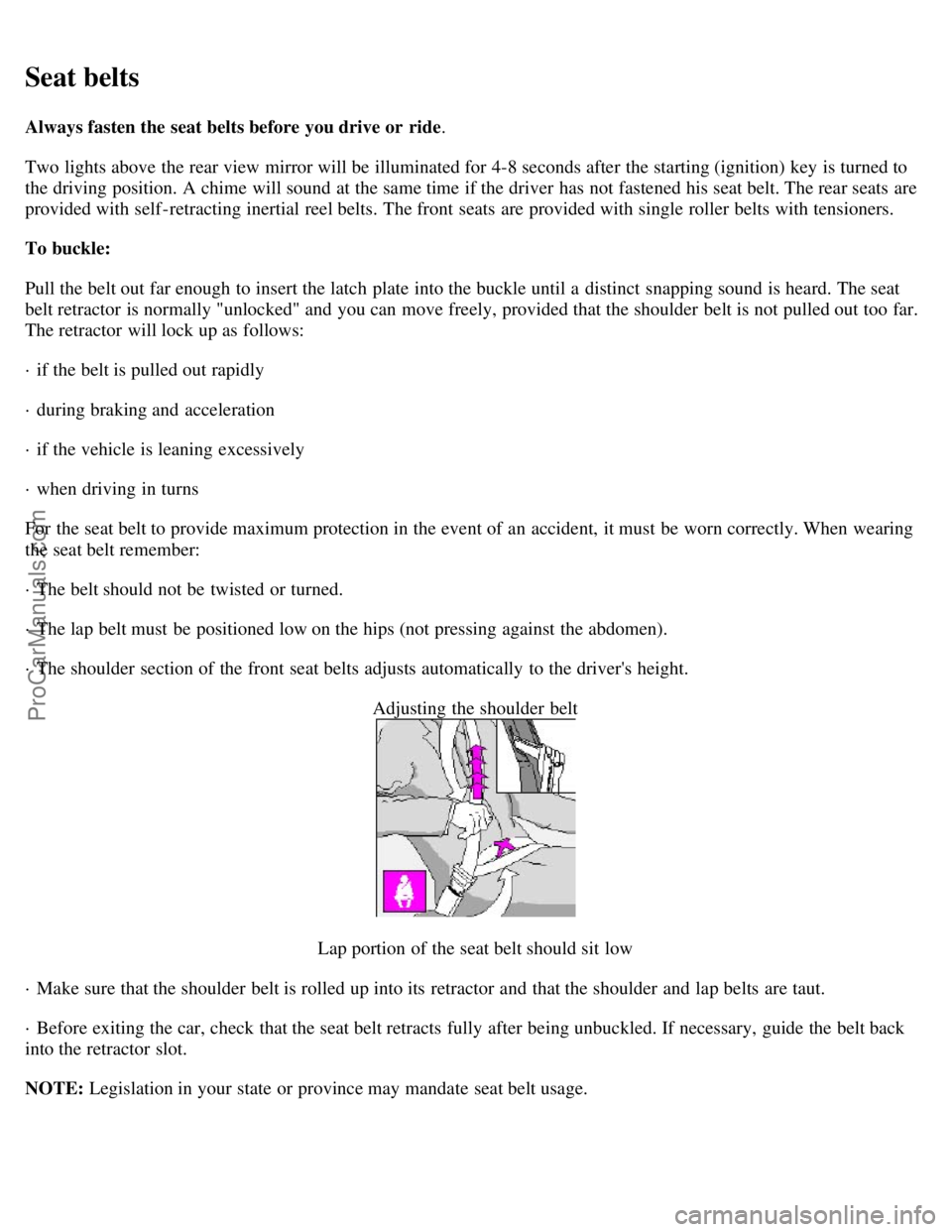
Seat belts
Always fasten the seat belts before you drive or ride.
Two lights above the rear view mirror will be illuminated for 4-8 seconds after the starting (ignition) key is turned to
the driving position. A chime will sound at the same time if the driver has not fastened his seat belt. The rear seats are
provided with self -retracting inertial reel belts. The front seats are provided with single roller belts with tensioners.
To buckle:
Pull the belt out far enough to insert the latch plate into the buckle until a distinct snapping sound is heard. The seat
belt retractor is normally "unlocked" and you can move freely, provided that the shoulder belt is not pulled out too far.
The retractor will lock up as follows:
· if the belt is pulled out rapidly
· during braking and acceleration
· if the vehicle is leaning excessively
· when driving in turns
For the seat belt to provide maximum protection in the event of an accident, it must be worn correctly. When wearing
the seat belt remember:
· The belt should not be twisted or turned.
· The lap belt must be positioned low on the hips (not pressing against the abdomen).
· The shoulder section of the front seat belts adjusts automatically to the driver's height. Adjusting the shoulder belt
Lap portion of the seat belt should sit low
· Make sure that the shoulder belt is rolled up into its retractor and that the shoulder and lap belts are taut.
· Before exiting the car, check that the seat belt retracts fully after being unbuckled. If necessary, guide the belt back
into the retractor slot.
NOTE: Legislation in your state or province may mandate seat belt usage.
ProCarManuals.com
Page 8 of 88

The rear head restraints can be adjusted according to the passenger's height. The restraint should be carefully adjusted
to support the occupant's head.
The head restraint can be raised by pulling straight up or lowered by pressing the catch (1) at the base of the left head
restraint support and pushing down.
Removing/replacing the head restraints
When folding the rear seats flat for carriage of cargo ( see page 55), head restraints should be fully removed by pulling
all the way up, pressing the catch at base of the left support and pulling the head restraint all the way out. Be sure to
reinstall and adjust head restraints to their proper position before allowing passengers to occupy the seats.
pg. 4 Volvo SRS
Passenger side SRS hatch
As an enhancement to the three-point seat belt system, your Volvo is equipped with a Supplemental Restraint System
(SRS). The Volvo SRS consists of an airbag (2) on both the driver's and passenger's sides and seat belt tensioners in
both front door pillars (4). The system is designed to supplement the protection provided by the three-point seat belt
system.
The SRS system is indicated by the "SRS" embossed on the steering wheel pad and above the glove compartment, and
by decals on both sun visors and on the far right side of the dash.
The airbags are folded and located in the steering wheel hub and above the glove compartment. They are designed to
deploy during certain frontal or front -angular collisions, impacts, or decelerations, depending on the crash severity,
angle, speed and object impacted. The airbags may also deploy in certain non-frontal collisions where rapid
deceleration occurs.
The airbag system includes gas generators (1) surrounded by the airbags (2) and front seat belt tensioners for both of
the front seats (4). To deploy the system, the sensor (3) activates the gas generators causing the airbags to be inflated
with nitrogen gas. As the movement of the seats' occupants compresses the airbags, some of the gas is expelled at a
controlled rate to provide better cushioning. Both seat belt tensioners also deploy, minimizing any seat belt slack.
ProCarManuals.com
Page 15 of 88
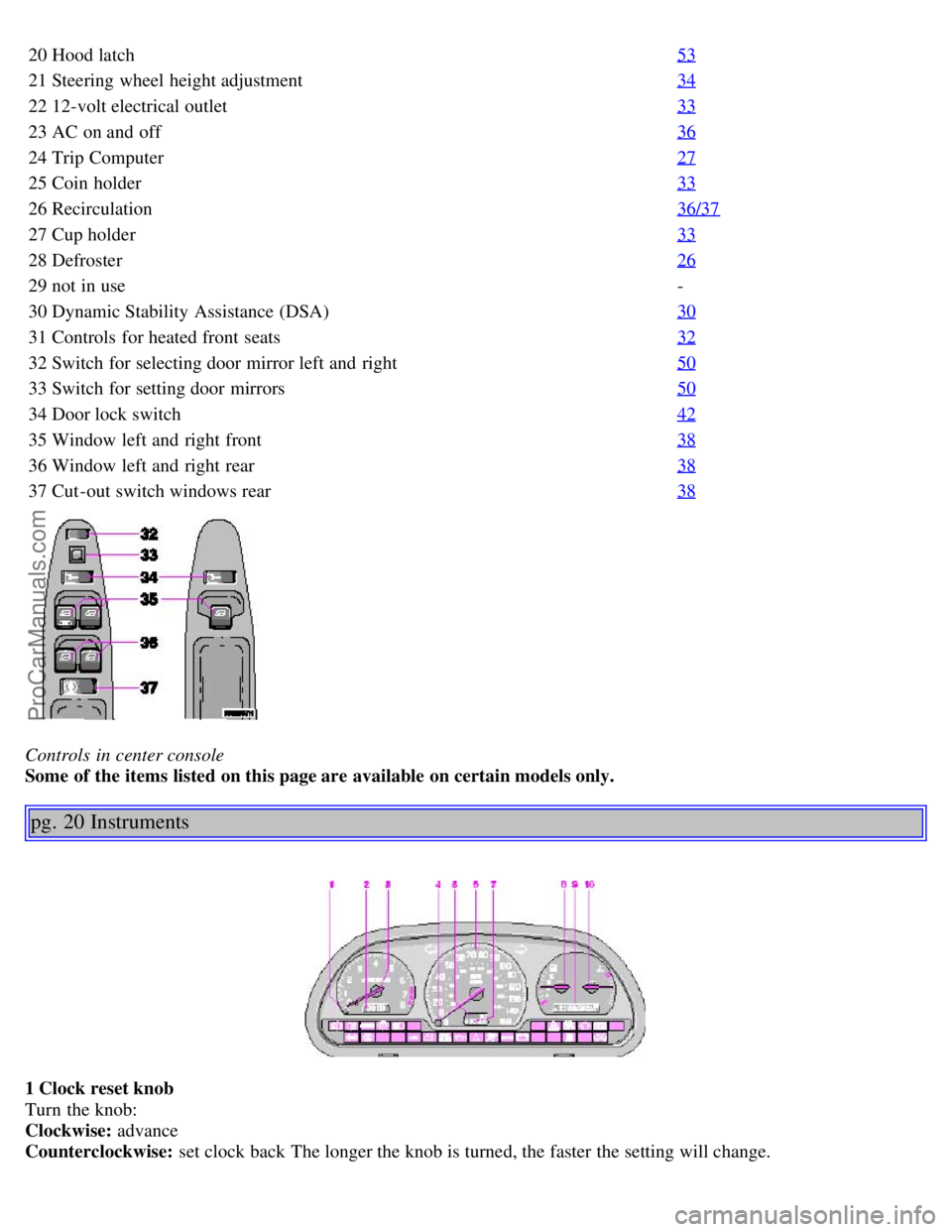
20Hood latch 53
21Steering wheel height adjustment 34
2212-volt electrical outlet 33
23AC on and off 36
24Trip Computer 27
25Coin holder 33
26Recirculation 36/37
27Cup holder 33
28Defroster 26
29not in use -
30 Dynamic Stability Assistance (DSA) 30
31Controls for heated front seats 32
32Switch for selecting door mirror left and right 50
33Switch for setting door mirrors 50
34Door lock switch 42
35Window left and right front 38
36Window left and right rear 38
37Cut -out switch windows rear 38
Controls in center console
Some of the items listed on this page are available on certain models only.
pg. 20 Instruments
1 Clock reset knob
Turn the knob:
Clockwise: advance
Counterclockwise: set clock back The longer the knob is turned, the faster the setting will change.
ProCarManuals.com
Page 38 of 88
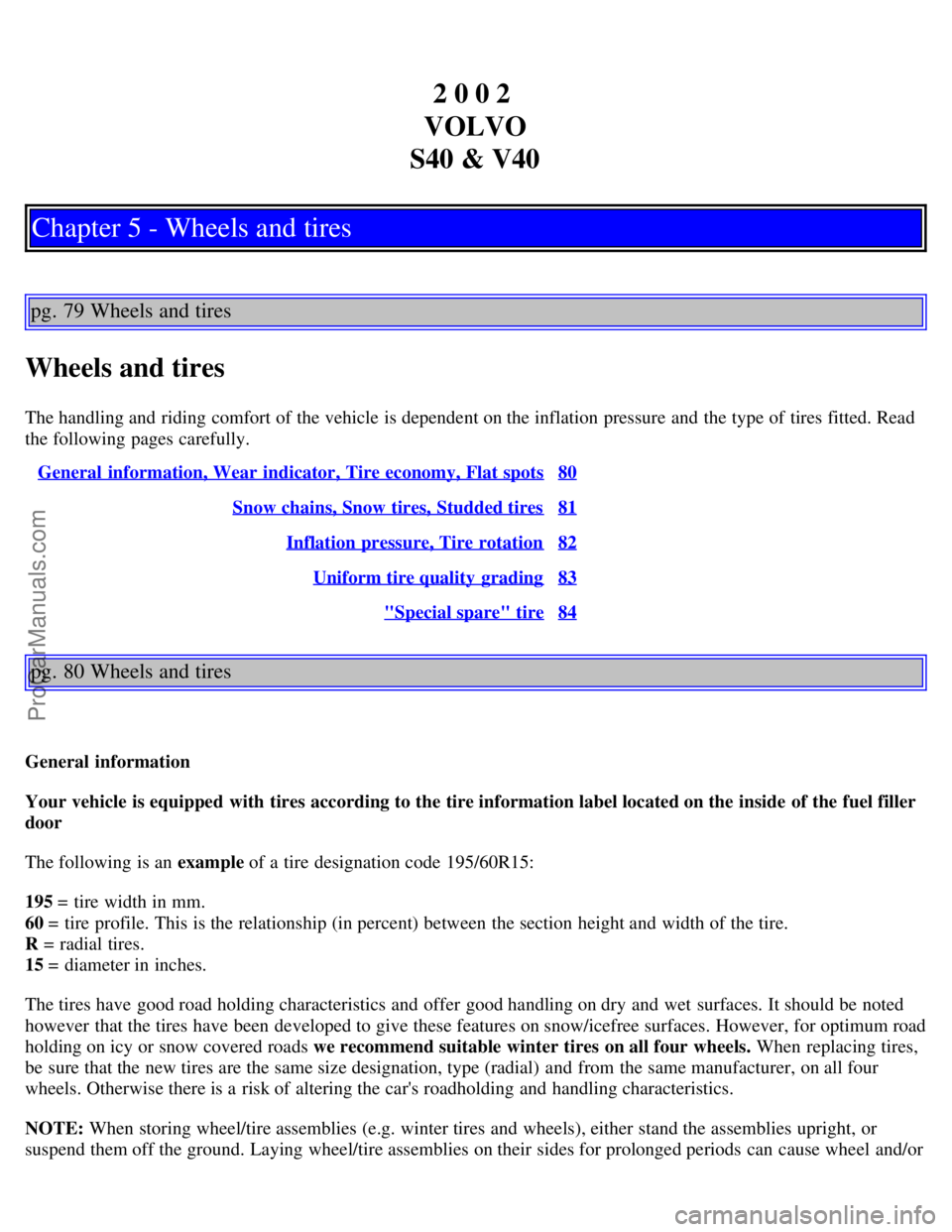
2 0 0 2
VOLVO
S40 & V40
Chapter 5 - Wheels and tires
pg. 79 Wheels and tires
Wheels and tires
The handling and riding comfort of the vehicle is dependent on the inflation pressure and the type of tires fitted. Read
the following pages carefully. General information, Wear indicator, Tire economy, Flat spots
80
Snow chains, Snow tires, Studded tires81
Inflation pressure, Tire rotation82
Uniform tire quality grading83
"Special spare" tire84
pg. 80 Wheels and tires
General information
Your vehicle is equipped with tires according to the tire information label located on the inside of the fuel filler
door
The following is an example of a tire designation code 195/60R15:
195 = tire width in mm.
60 = tire profile. This is the relationship (in percent) between the section height and width of the tire.
R = radial tires.
15 = diameter in inches.
The tires have good road holding characteristics and offer good handling on dry and wet surfaces. It should be noted
however that the tires have been developed to give these features on snow/icefree surfaces. However, for optimum road
holding on icy or snow covered roads we recommend suitable winter tires on all four wheels. When replacing tires,
be sure that the new tires are the same size designation, type (radial) and from the same manufacturer, on all four
wheels. Otherwise there is a risk of altering the car's roadholding and handling characteristics.
NOTE: When storing wheel/tire assemblies (e.g. winter tires and wheels), either stand the assemblies upright, or
suspend them off the ground. Laying wheel/tire assemblies on their sides for prolonged periods can cause wheel and/or
ProCarManuals.com
Page 68 of 88
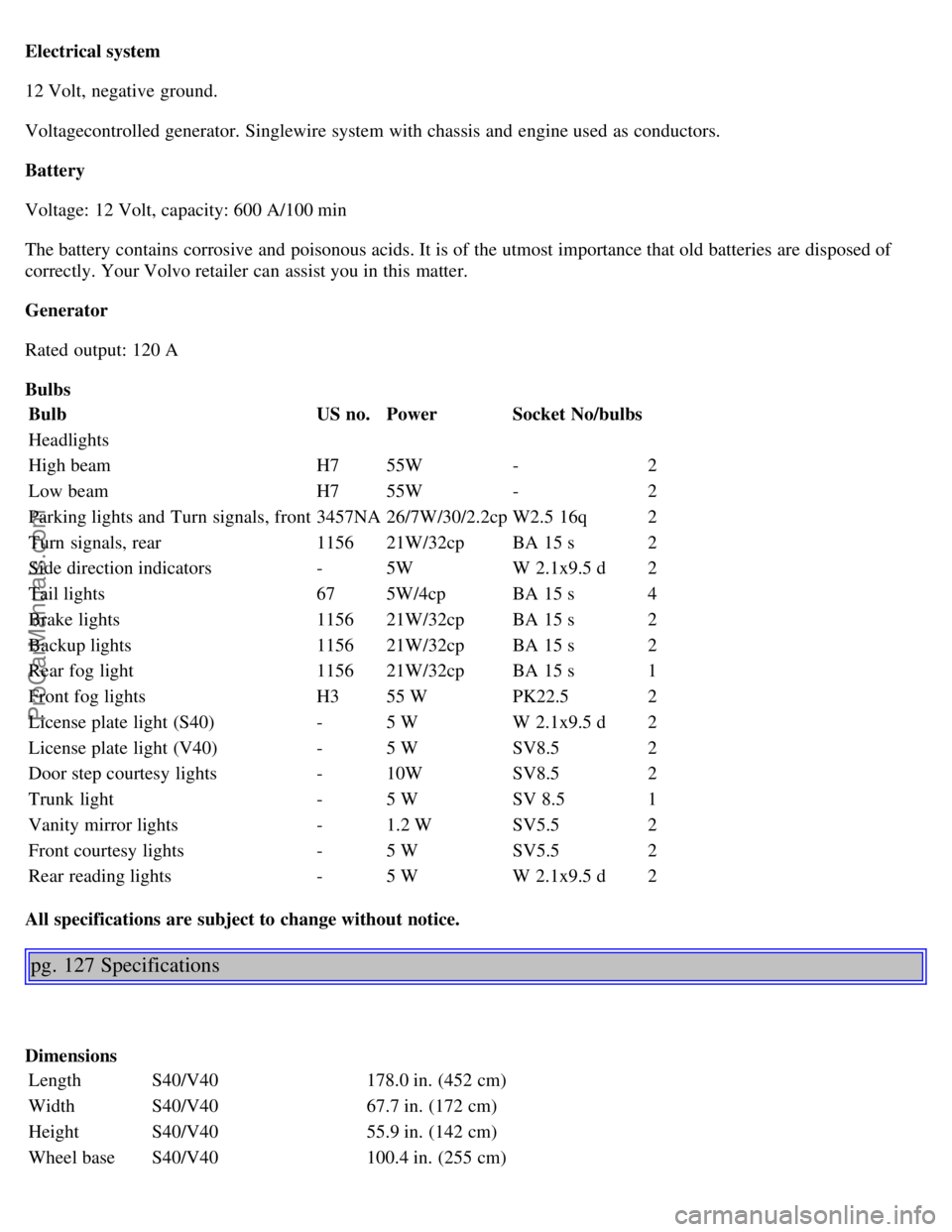
Electrical system
12 Volt, negative ground.
Voltagecontrolled generator. Singlewire system with chassis and engine used as conductors.
Battery
Voltage: 12 Volt, capacity: 600 A/100 min
The battery contains corrosive and poisonous acids. It is of the utmost importance that old batteries are disposed of
correctly. Your Volvo retailer can assist you in this matter.
Generator
Rated output: 120 A
BulbsBulb US no.Power Socket No/bulbs
Headlights
High beam H755W - 2
Low beam H755W - 2
Parking lights and Turn signals, front 3457NA26/7W/30/2.2cp W2.5 16q 2
Turn signals, rear 115621W/32cp BA 15 s 2
Side direction indicators -5W W 2.1x9.5 d 2
Tail lights 675W/4cp BA 15 s 4
Brake lights 115621W/32cp BA 15 s 2
Backup lights 115621W/32cp BA 15 s 2
Rear fog light 115621W/32cp BA 15 s 1
Front fog lights H355 W PK22.5 2
License plate light (S40) -5 W W 2.1x9.5 d 2
License plate light (V40) -5 W SV8.5 2
Door step courtesy lights -10W SV8.5 2
Trunk light -5 W SV 8.5 1
Vanity mirror lights -1.2 W SV5.5 2
Front courtesy lights -5 W SV5.5 2
Rear reading lights -5 W W 2.1x9.5 d 2
All specifications are subject to change without notice.
pg. 127 Specifications
Dimensions Length S40/V40 178.0 in. (452 cm)
Width S40/V40 67.7 in. (172 cm)
Height S40/V40 55.9 in. (142 cm)
Wheel base S40/V40 100.4 in. (255 cm)
ProCarManuals.com
Page 69 of 88
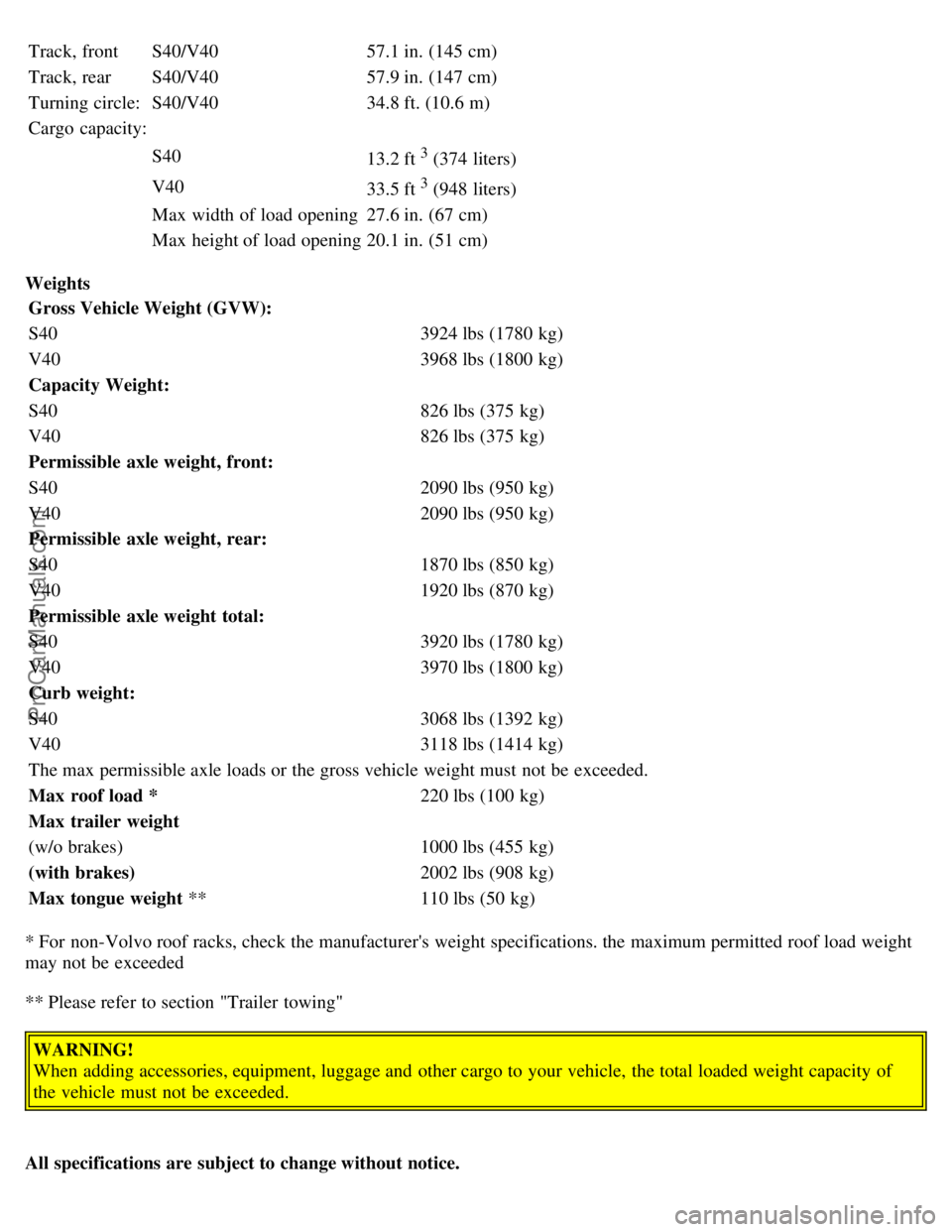
Track, frontS40/V40 57.1 in. (145 cm)
Track, rearS40/V40 57.9 in. (147 cm)
Turning circle: S40/V40 34.8 ft. (10.6 m)
Cargo capacity:
S40 13.2 ft
3 (374 liters)
V40 33.5 ft
3 (948 liters)
Max width of load opening 27.6 in. (67 cm)
Max height of load opening 20.1 in. (51 cm)
Weights Gross Vehicle Weight (GVW):
S40 3924 lbs (1780 kg)
V40 3968 lbs (1800 kg)
Capacity Weight:
S40 826 lbs (375 kg)
V40 826 lbs (375 kg)
Permissible axle weight, front:
S40 2090 lbs (950 kg)
V40 2090 lbs (950 kg)
Permissible axle weight, rear:
S40 1870 lbs (850 kg)
V40 1920 lbs (870 kg)
Permissible axle weight total:
S40 3920 lbs (1780 kg)
V40 3970 lbs (1800 kg)
Curb weight:
S40 3068 lbs (1392 kg)
V40 3118 lbs (1414 kg)
The max permissible axle loads or the gross vehicle weight must not be exceeded.
Max roof load * 220 lbs (100 kg)
Max trailer weight
(w/o brakes) 1000 lbs (455 kg)
(with brakes) 2002 lbs (908 kg)
Max tongue weight ** 110 lbs (50 kg)
* For non-Volvo roof racks, check the manufacturer's weight specifications. the maximum permitted roof load weight
may not be exceeded
** Please refer to section "Trailer towing"
WARNING!
When adding accessories, equipment, luggage and other cargo to your vehicle, the total loaded weight capacity of
the vehicle must not be exceeded.
All specifications are subject to change without notice.
ProCarManuals.com